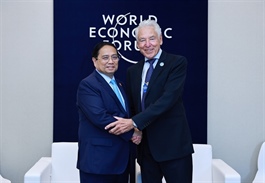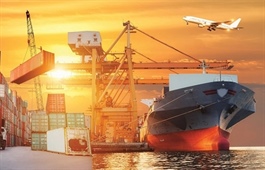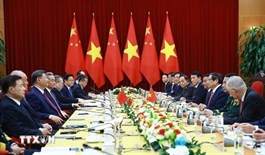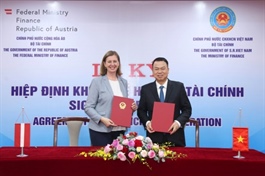Structural reforms difficult but essential for growth
Structural reforms difficult but essential for growth
Vietnam is navigating a critical juncture where rising asset valuations and institutional readiness will determine how successfully it can leverage strategic investments. David Barrett, CEO of EBC Financial Group (UK), shared his insights with VIR’s Nha Phuong on the underlying economic dynamics and structural reforms required.
What valuation trends are emerging in Vietnam’s infrastructure, logistics, and energy sectors amid heightened geopolitical interest?

David Barrett, CEO of EBC Financial Group (UK) |
The continued strength of Vietnam’s foreign direct investment (FDI) flows, along with the political pressure for some manufacturing to pull away from China, have had a significant impact on the valuations seen for local assets. Real estate, warehousing, logistics, labour, and e-commerce have all seen rises.
If you are a firm looking to establish or expand in the region, Vietnam has much to attract you: deepwater ports, global trade route access for your goods, modernised rail and road links, high-tech warehousing, a strong shift to renewables, and a government that is making it easy for firms to establish themselves.
Domestic reforms, geopolitical themes, and trade tension have all meant demand is up. This demand often outstrips supply in the short term, leading to inevitable cost and valuation moves higher.
This demand encourages investors, increases domestic worker wealth, and increases the government’s ability to modernise and invest – all good news. The bad news is it adds to the continuing struggle to keep inflation under control. Everything that has helped Vietnam over the last two decades makes them more vulnerable to price shocks, demand supply imbalances, supply chain disruptions, and more.
How do you assess the macroeconomic implications of rising foreign capital inflows on Vietnam’s currency stability and monetary policy?
FDI flows have been a significant contributor to the Vietnam economy for many years. Since the 1980’s, it has played an ever-increasing role in how the economy has grown and is now a major source of capital for the country. Indeed, 2024 showed record disbursed flows and 2025 has started off strongly as well.
The implications on VND are not as clear as they might seem. At first sight, the pressure of the FDI flow would indicate appreciation pressure, but this really depends on where you look. Over the last 10 years, we can see the VND approximately 20 per cent weaker against the USD and the Euro. That is only half the story though, if we look at its performance against economic competitors we see a different story.
Government policy has been competitive on the global economic stage. VND also sees an increasing demand for hedging by local firms and while Vietnam normally runs a trade surplus, they have seen significant pressure from the price of energy imports and repatriation of profits earned by those offshore investors.
How do you evaluate Vietnam’s competitiveness in attracting green technology investments compared to other ASEAN peers?
Morally, there is a great argument for Vietnam to push hard into this sector. As a growing economic force that is still young compared to many of the global stage, it has a great opportunity to invest and benefit from green technology. It already has a substantial footprint in solar and wind: the government is pushing for renewables to count for 20 per cent of the energy chain by 2030 and is part of the Paris Accord, which has a carbon-neutral goal by 2050.
The downside to the good news is that to scale up to its goals it is going to need to spend a lot more money on the transmission infrastructure – for the whole country to benefit the grid into different regions will need to be a lot bigger and more robust.
This issue is not particular to Vietnam. Western economies have seen a large pushback when the real cost of providing renewables is laid out. This pushback has seen capital being diverted, and government subsidies criticised as the true cost of production becomes clear.
For the government to stay on the path it has set out, it will need to be clear about the real environmental positives that are achievable while also helping people understand this is a long-term project.
What structural reforms or institutional improvements would enhance Vietnam’s ability to absorb and deploy large-scale strategic capital efficiently?
This phase of the Vietnam economy is still young, and the growth and impact seen since the mid-1980s has been vast and very rapid. Any nation that sees this degree of change tends to also see it outstrip the governance, legal, infrastructure, and government changes needed to keep that growth over the medium and long term.
In terms of governance and regulation, the rule of law and a clear regulatory framework help create a level playing field for all participants. When individuals and firms believe they have a fair chance to succeed alongside large corporations, it fosters a more vibrant economic environment, combats corruption, protects intellectual property, and promotes economic progress.
Long-term infrastructure projects are crucial. Countries must also develop a workforce capable of supporting sustained growth, which requires a modern education system with access to mathematics, science, and technology to build the necessary skill base. As growth occurs, it leads to higher incomes, greater prosperity, and stronger domestic consumption.
Finally, developing a robust local capital market is essential. A well-functioning equity market facilitates capital raising for smaller enterprises, while an expanded banking infrastructure enables efficient distribution and leveraging of incoming funds across the financial ecosystem.
- 09:45 26/06/2025

























